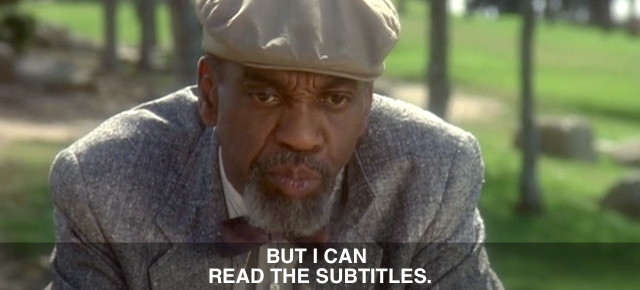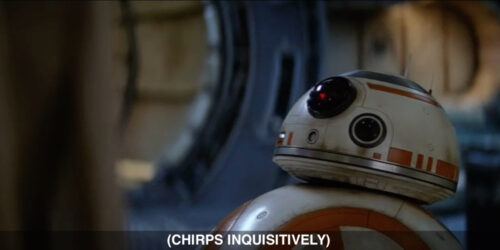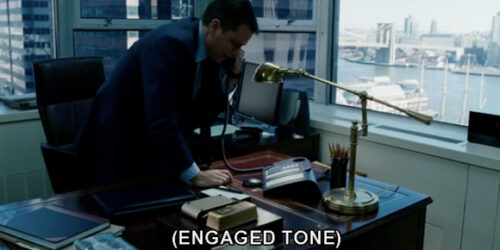“Subtitles I like to ride on”: When medium awareness extends to subtitles

When fictional characters break through the fourth wall to comment on the subtitles…
The first time I saw the guy in the Dairy Queen commercial hop on the subtitles and hilariously ride them as they chugged off the screen, I began searching for other examples in which characters showed an awareness of the subtitles. The examples I subsequently found, while not strictly accessible to deaf and hard-of-hearing viewers without the support of an additional caption track, nevertheless have the potential to increase awareness of subtitles and subtitling practices.
Subtitling practices occasionally break through to become a topic of discussion among mainstream audiences. For example, when the Papyrus typeface was used for the subtitles in Avatar, it was universally panned by designers and typophiles. Three quick examples:
- The title of an article on Gizmodo — “I Spent $300 Million on This Movie and All I Got Were These Lousy Papyrus Subtitles” — sums up the sentiment nicely.
- An open letter to James Cameron from Papyrus on the Pr*tty Sh*tty site satirically congratulated Cameron: “Kudos to you for not spending a single cent of your massive budget on an expensive, attractive font for the subtitles, and opting to put me to the task instead.”
- A contest on a design website asked designers to choose a new typeface to replace “possibly the least desirable typeface available to the design community for the subtitles of the film’s fictional species, the Na’vi.”
The Dairy Queen commercial is compelling to me for the way it similarly elevates subtitles to a topic of discussion. Subtitles become integral, meaningful elements of the text in their own right. They don’t support or translate the primary meaning of the text, or try to sit unobtrusively at the bottom of the screen. Instead, they make their own meaning. We are asked to look at them, not merely look through them.
The examples that follow elevate subtitles by breaking through the so-called fourth wall. The imaginary fourth wall separates the audience from the action on screen or stage. When the audience suspends its disbelief, the events are taken as real and believable. When fictional characters show an awareness of the medium (e.g. by talking directly into the camera, commenting on the soundtrack, bumping into or referring to the subtitles, etc.), they break through the fourth wall that enables the audience’s suspension of disbelief.
Put simply, fictional characters are not supposed to see subtitles. When they can, it’s usually in the service of a joke.
Loaded Weapon (1993)
Austin Powers in Goldmember (2002)
Warning: Content may be offensive.
The Man with Two Brains (1983)
Fatal Instinct (1993)
Bugsy Malone (1976)
Wayne’s World (1992)
Portlandia, “Baseball” (Season 1, Ep 6, 2011)
Warning: Content may be offensive.
Closed Captions, Setting the Site (Vimeo)
Subtitled Arab (YouTube)
Warning: Content may be offensive.
As you can see, medium awareness of subtitles is often channeled through comedy, especially the screwball variety. This isn’t surprising, since breaks in the fourth wall are often used for comedic effect. When a movie threatens the presumed sanctity of the fourth wall, viewers are moved out of the real and into the absurd.
Because subtitles in these examples share the same space on the screen with the closed captions, designers and captioners must strive to avoid conflict and overlap (e.g. see the Portlandia and Goldmember examples). It’s important to remember that some viewers will be trying to process two text streams at the same time: the on-screen subtitles and the closed captions.
What additional examples of medium awareness (involving subtitles) are you aware of?
[A note on method: A number of these examples were found on TVtropes.org, which is an excellent repository for all kinds of examples of medium awareness.]
[Fair use notice: The videos on this site are transformative works used in good faith, in keeping with Section 107 of U.S. copyright law, and as such constitute fair use of copyrighted material. Read this site’s full fair use notice.]






This is the first one that comes to mind.
http://www.youtube.com/watch?v=B7UmUX68KtE
This is a great list! I really enjoyed watching them. I agree that it’s too bad when a joke involving the subtitles makes the subtitles themselves less accessible, though. Definitely something to keep in mind for fourth wall breakers in the future.
Thanks for this. Great stuff.
Lauren
http://www.ccacaptioning.org – the place to be for captioning advocacy – free membership – collaborations for inclusion of quality captioning universally. Now inviting contributors and sponsors for new newsletter to be launched soon.
I think Marshall McLuhan had it right this many years ago: the medium is the message! Nonetheless, it is insteresting and instructive to know that our society has accepted deafness and hard of hearing conditions so well as to integrate accessibility into the comedic mainstream and the “oddball” appreciative younger generation who “get it” will hopefully be comfortable enough to do something constructive and useful with it.
Messing with Marjorie http://www.youtube.com/watch?v=v2fYL7FJXg8
http://www.youtube.com/watch?v=RFAulpHi0kA
skip ahead to about 1:55 then watch.
What a great collection put together. I love comedy mixed with subtitles.It’s a simple concept but they deliver it well – they are making comedy out of the voice recognition technology used to provide automatic captions which are often wrong! http://youtu.be/hVNrkXM3TTI